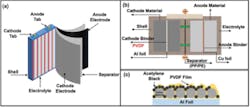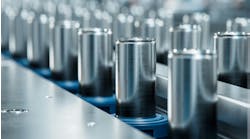Barry on Batteries: Bringing Process Safety to Lithium-Ion Materials
The list of chemicals to make a lithium-ion battery is long and complex. There are solids and solvents involved for reactions or precipitation, purification and drying. There are different equipment technologies for each step as well as for solids handling. Operators and process engineers must be experts in all these areas to safely produce these battery materials and chemicals.
In my 40 years in the chemical industry, I have seen firsthand the improvement in process safety from the equipment side and operations side. Starting with reaction/precipitation, agitators are more robust. The double-purged mechanical rotating seals eliminate solvent emissions, and computation fluid dynamic (CFD) modeling for flow simulation optimizes the crystallization.
Many types of equipment technology today are designed to eliminate operator exposure. For example:
- For pressure filtration, there are agitated Nutsche filter-dryers as well as fully enclosed filter presses.
- Vacuum belt filters are designed with low-pressure housings to allow for inert-gas purging under vacuum as well as contained solids discharge.
- Centrifuges are designed for containment and isolation from the operating environment.
- For processing of low solids or liquids, plate filters and candle/tubular filters offer an alternative to disposable manual bag and cartridge filters.
- Dryers and vacuum systems are designed for full recovery of vapor dusts, solvent-ladened gas streams, and final product dusting.
For solids handling, there are many systems available for charging of solids into vessels (powder pumping), solids discharge (isolation and rotary valves, liners) and solids conveying (pneumatic and pressurized screw conveyors). These techniques eliminate the particulate emissions during solids transport.
An important topic is the instrumentation that surrounds all the equipment. Instrumentation vendors have sophisticated techniques for monitoring and preventing exposures, and engineers must investigate the “smart” approaches to equipment.
While the above focus on safety is on machine design, operator safety training, personal protective equipment (PPE), and safety cultures at the plants are also improving. There are many different approaches including the use of hazard and operability studies to ensure that plants are operating safely.
Battery Chemicals vs. TSCA
Recently, there have been discussions concerning new rules by the U.S. Environmental Protection Agency (USEPA) for regulating toxic chemicals. In a New York Times article, “Public Health vs. Economic Growth: Toxic Chemical Rules Pose Test for Biden,” there is a debate over the limits being considered for 10 chemical substances for initial risk evaluations under the Toxic Substances Control Act. One of the chemicals debated is important in battery materials: N-Methylpyrrolidone (NMP) is used to remove the polyvinylidene fluoride (PVDF) binder from the cathode material (as shown in Figure 1). The cathode active material and conductive agent acetylene black are chemically bonded with current collector Al foil by PVDF, and batter makers use NMP to dissolve the PVDF during recycling operations.
The debate around regulation of NMP and the other nine listed chemicals is beyond the scope of this column. However, as discussed above, the equipment and approaches exist to minimize and eliminate exposure to these chemicals. In addition, there is ongoing research into developing fluorine-free alternative materials and solid-state electrolytes for lithium-ion batteries. Advances in this direction will also change the discussion.
In science and engineering, there is often no clear answer to a “social-good” question, but with collaborative and holistic approaches, the pathway will be found.




